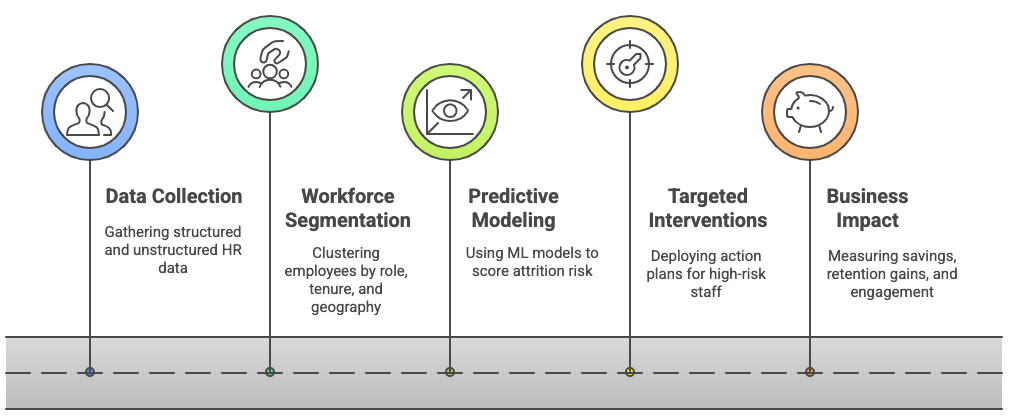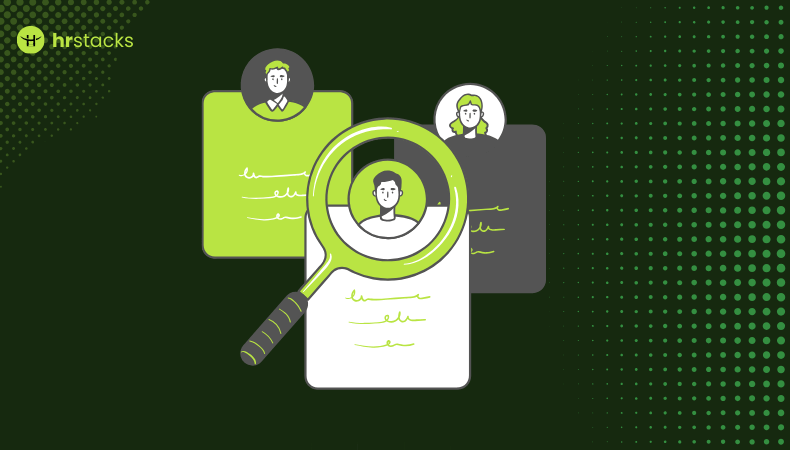Employee turnover isn’t just an HR headache; it’s a strategic challenge that saps productivity, morale, institutional knowledge, and most critically, money.
Research shows that replacing an employee can cost between 50% and 200% of their annual salary. Yet, too many companies remain reactive: waiting for exit notices before taking action.
This article shifts that paradigm. It outlines a step-by-step, data-infused approach to predicting and preventing attrition. You’ll learn how to collect and unify meaningful HR data, craft predictive models, design targeted retention interventions, and measure impact continuously, all while navigating legal and ethical considerations.
Case studies from Deloitte, IBM, Experian, and other organizations demonstrate what is possible with smart analytics and human insight.
Whether you’re an HR leader, manager, or consultant, these insights will help you build a proactive retention strategy, keeping talent, safeguarding culture, and saving millions.
The Strategic Value Of Data-Driven Retention
Organizations can transform retention from a reactive cost center into a strategic advantage by proactively leveraging employee data.
Predictive HR analytics have been shown to reduce turnover by up to 25%, boost engagement by over 30%, and deliver over 300% ROI, underscoring the tangible financial and cultural benefits of forecasting flight risk before it’s too late.
The real cost of attrition
Turnover’s impact extends beyond a hiring fee; it disrupts productivity, erodes morale, and often hampers customer satisfaction. Gartner reports that organizations deploying mature HR analytics reduce turnover by up to 25%.
Moving from reactive to predictive retention
HR leaders are increasingly using data to preempt attrition. By identifying departure risks weeks or months ahead, companies can protect key talent and minimize costly departures.
Strategic outcomes
• Cost savings: Experian reduced its global attrition by 4%, saving CAD 14 million over two years.
• Retention targets met: A global pharmaceutical giant in China achieved a 98% retention rate among its high-value sales team using analytics-led initiatives.
• Operational uplift: A U.S. logistics provider cut first-year attrition by 35%, saving $4 million and boosting productivity by 20%.
Predictive Retention Process

Data Foundation: Building Your Analytics Base
Now that we’ve seen what’s possible with analytics-led retention, let’s break down how to build the necessary data foundation.
A strong analytics foundation begins by centralising and integrating data from diverse HR systems, such as HRIS, performance reviews, engagement surveys, training logs, attendance, and exit interviews, to enable a complete and unified view of your workforce.
Next, ensuring high data quality and structure, through consistent formatting, cleaning, de-duplication, and proper governance, lays the groundwork for reliable predictive modeling and actionable insights.
Audit And centralize Data
Start with an HR data inventory: HRIS, performance reviews, compensation details, training logs, engagement surveys, and exit interviews. Integrate these sources to eliminate silos.
A KSA‑based bank used Dataiku and Tableau to merge HRMS, satisfaction surveys, and performance data, achieving 86% predictive accuracy in forecasting attrition risk.
Include Behavioral And Sentiment Signals
Beyond structured datasets, incorporate unstructured feeds: email patterns, chat sentiment, and even attendance timeliness.
Netscribes, for instance, layered Slack, survey, and learning data to detect disengagement through subtle “morale dip” signals, triggering early alerts.
Data Quality Essentials
Ensure consistently formatted, de‑duplicated, and accurate data. Address class imbalances when attrition rates are low. Use feature engineering and data exploration to uncover what really matters before modeling.
Workforce Segmentation: Identifying Risk Patterns
Effective workforce segmentation divides employees into meaningful groups based on shared traits, such as role, tenure, or performance, revealing important variations in behaviours and attrition drivers.
By understanding these segments, organizations can tailor retention strategies and pinpoint high-risk cohorts more accurately, ultimately enhancing engagement and reducing turnover.
Workforce cluster analysis
Segment employees by role, tenure, performance, and geography. Analytics often reveals that risk drivers differ across clusters.
A Deloitte pharma case used segmentation and modeling to assign risk scores from 1–100, enabling fine-grained, location-specific interventions.
Identify risk factors
Analyze variables like career progression, manager feedback, workload spikes, and remuneration changes.
LDA-based topic modeling has been used to extract attrition reasons from exit interviews and feed into predictive models.
Leverage organizational network analysis (ONA)
Evaluate informal working relationships, who collaborates with whom. Weak network ties often signal isolation and a higher likelihood of departure.
Predictive Modeling: Forecasting Attrition Risk
Predictive modeling employs advanced statistical and machine learning algorithms, such as logistic regression, random forests, and gradient boosting, to analyze historical HR data and calculate a personalized “flight risk” score for each employee.
These models surface trends that traditional methods miss, such as declining engagement or abrupt workload shifts, enabling HR teams to flag potential departures months in advance and focus retention efforts on high-risk individuals
- Modeling techniques: Use classification algorithms (logistic regression, random forest, gradient boosting) to predict attrition. Random forest models have achieved ~86% accuracy. Ensemble ML approaches are common, with some systems performing as well as 95% accuracy.
- Modern approaches using LLMs: Recent research using fine-tuned GPT‑3.5 shows promise, with F1 scores up to 0.92 on attrition prediction, suggesting potential in capturing nuanced communication signals.
- Interpretability matters: Explainable AI techniques (e.g., SHAP values) show managers which variables drive the model’s predictions, providing clarity and trust.
- Pilot, validate, scale: Test the model on a validation set before broader deployment. Fine-tune hyperparameters and monitor false positives. Scale gradually to ensure reliability.
Targeted Interventions: Turning Insights Into Action
To translate risk insights into action, organizations deploy targeted interventions tailored to flagged employees’ needs, such as mentorship, coaching, workload adjustments, and well-being support.
Evidence shows mentorship reduces turnover by up to 49%, while structured coaching boosts confidence, job satisfaction, and retention among high-potential staff.
Once high-risk employees are identified, apply tiered retention strategies:
- Mentorship & career pathing: Customized mentorship programs have been shown to boost engagement. Globaltize posted a 25% rise in engagement through this approach.
- Manager coaching: Equip leaders with data-driven scripts and alerts. Netscribes empowered managers through personalized communications that addressed early risk signals.
- Workload recalibration: Rebalance tasks for at-risk staff, either by adjusting responsibilities or reallocating support to avert burnout cycles.
- Sentiment‑based outreach: Use NLP to track internal communications and trigger welfare check-ins. IBM’s AI model achieved 95% predictive accuracy, allowing for early intervention.
- Onboarding enhancements: Early attrition is common among new employees. Studies show that extended onboarding reduces first-year turnover by 25%. FOUNT’s case study saw a 35% attrition reduction among warehouse workers through structured onboarding and mentorship.
- Compensation & recognition review: Benchmark pay and recognition programs against industry standards, revisiting reward strategies for high-value employees to strengthen loyalty.
Continuous Monitoring: Measurement & Refinement
To maximize impact, retention efforts must evolve through continuous monitoring and data-driven refinement. Central to this is an interactive HR analytics dashboard that tracks key metrics, such as flight risk scores, turnover rates, engagement trends, and intervention effectiveness, in real time.
Ideally, dashboards integrate data from HRIS, performance systems, engagement surveys, and communication platforms, offering department-level and individual risk insights.
Best-in-class dashboards are designed with clear user goals, intuitive visuals, and interactivity, enabling HR leaders and managers to filter by team, tenure, or role, and easily drill down for granular insight. Regular feedback loops are key: gather input from HR and leadership to update dashboards and refine model parameters continuously.
Real-time monitoring accelerates insight-to-action cycles. For example, Tata Consultancy Services reported a 20% drop in absenteeism after deploying dashboards that delivered weekly alerts for department spikes.
Meanwhile, AI-powered systems can self-adjust as new patterns emerge, retraining models to maintain accuracy above 80–90%. The result: a dynamic retention engine that adapts to evolving risk factors and delivers sustained workforce stability.
Ethical, Legal & Cultural Considerations
It’s crucial to acknowledge the ethical, legal, and cultural dimensions of data-driven retention. Organizations must balance powerful predictive insights with rigorous data privacy protections, transparency about data use, and proactive efforts to eliminate algorithmic bias.
These steps help maintain trust and ensure retention initiatives respect both employee rights and regulatory requirements.
- Compliance & privacy: Respect data privacy laws (GDPR, CCPA) and transparency, inform employees about data use, secure consent, and avoid misuse.
- Avoid algorithmic bias: Check for model biases related to gender, ethnicity, or age. Use fairness evaluation tools, and ensure interventions reflect modern DE&I best practices.
- Balance human touch: Treat analytics as decision-support, not as command systems. Always contextualize insights with manager discretion and personal knowledge.
- Transparent communication: Explain why data is being used to identify risk. Position systems as tools to support, not surveil, employees.
Expanded Case Studies
It’s important to note that leading organizations across industries have successfully leveraged predictive retention analytics to drive measurable improvements.
Their results, ranging from 98% retention rates and multi-million-dollar savings to sharply reduced first-year turnover, demonstrate the power of combining robust data models with thoughtful, targeted interventions.
Deloitte & Global Pharma In China
A large pharmaceutical company in China partnered with Deloitte to address alarming sales turnover. Over three years, they aggregated performance metrics, span of control, benefits data, and supervisor evaluations to construct a predictive model.
Each sales representative received a personalized retention score, visualized via interactive dashboards that enabled managers to drill down by region and employee.
Within a year, voluntary turnover in critical roles plunged to just 2%, resulting in an impressive 98% retention rate.
Experian’s Global Rollout
Experian faced attrition rates 4% above industry benchmarks and quantified that every 1% increase in turnover cost approximately US $3 million globally.
In response, they built an internal predictive workforce analytics platform using around 200 employee attributes, spanning team size, supervisor performance, commute distance, and more.
After two years, global attrition declined by 4%, translating into approximately CAD $14 million in savings.
IBM’s AI-Powered Model
IBM implemented a sophisticated AI-driven attrition model that achieved roughly 95% prediction accuracy.
High-risk employees identified by the system received timely, personalized outreach, frequently involving manager-led career discussions, career-path coaching, and well-being support.
These proactive interventions helped reduce stress factors, strengthen engagement, and diminish unexpected departures.
Sol Analytics – KSA Banking
In Saudi Arabia, a major bank engaged Sol Analytics to develop a predictive retention solution using Dataiku and Tableau.
Their random forest model, which reached 86% accuracy, revealed that low engagement scores strongly correlated with higher attrition risk. These insights shaped targeted career-pathing initiatives and manager coaching programs that significantly curbed turnover.
FOUNT’s Logistics Intervention
A retail logistics company battling a staggering 110% first-year attrition among its 800 warehouse employees implemented a comprehensive strategy combining entry-level surveys, enhanced onboarding, shift-coach videos, workload adjustments, and facility layout redesigns.
Over time, these interventions reduced attrition by 35%, saving approximately US $4 million annually.
Netscribes’ Real-Time Engagement Alerts
A U.S.-based services firm leveraged real-time sentiment analysis and engagement indicators, such as shifts in internal communications, to trigger proactive manager-led check-ins.
This promptly addressed emerging morale issues, which improved engagement levels and significantly decreased surprise departures.
Implementation Roadmap
To ensure sustainable success, organizations should follow a structured, phased roadmap that guides them from data readiness to predictive analytics deployment and continuous improvement.
This approach minimizes risk and maximizes impact, turning retention efforts into strategic, measurable outcomes.
- Conduct HR systems audit – Evaluate existing tools, identify data gaps, and assess analytical readiness.
- Define measurable objectives and KPIs – Align retention targets and analytics goals with strategic business outcomes.
- Centralize diverse employee data – Consolidate HRIS, engagement surveys, performance records, and exit interview insights.
- Build a cross‑functional analytics team – Include HR, data scientists, and IT to ensure holistic execution.
- Select and integrate analytics platform – Choose BI tools or HR‑specialist software, connecting all relevant data sources.
- Pilot predictive modeling – Run initial retention risk models on a defined segment before scaling broadly.
- Launch targeted interventions – Deploy mentorship, wellness, and workload balance for flagged high-risk employees.
- Implement real‑time dashboards – Track risk scores, engagement, interventions, and retention outcomes continuously.
- Review, refine, scale – Regularly update models, interventions, and metrics based on performance and employee feedback.
Conclusion
By blending predictive analytics with strategic, human-centered interventions, HR teams can turn attrition from an unpredictable challenge into a manageable outcome.
As the case studies demonstrate from Deloitte’s 98% retention rate to IBM’s 95%, accurate support model and Experian’s multi-million-dollar savings, data-driven retention programs don’t just safeguard valuable talent; they deliver measurable financial returns.
The key lies in combining reliable data pipelines, transparent governance, empathic leadership, and iterative measurement. Start small, iterate based on what the analytics reveal, and scale interventions thoughtfully.
With this approach, any organization, from lean startups to global enterprises, can move beyond guessing who will stay and instead build a loyal, thriving workforce.










